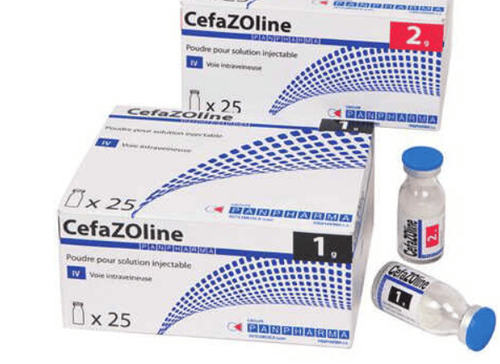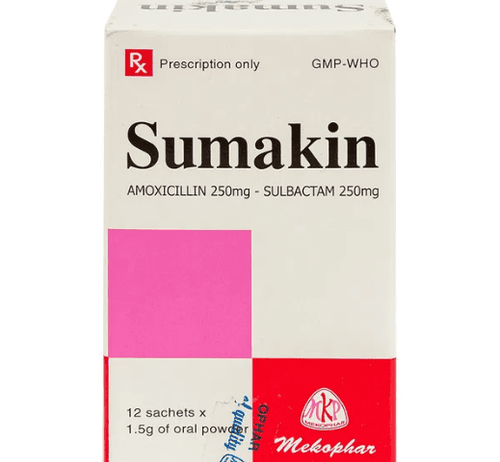This is an automatically translated article.
Farisul is an oral antibiotic, after entering the body the drug is hydrolyzed into Ampicillin and Sulbactam. With these two components combined, the drug is effective on many types of bacteria, increasing the antibacterial spectrum compared to using single Beta lactam drugs.
1. What are the effects of Farisul?
Farisul drug has the main ingredients:
Sultamicillin (in the form of Sultamicillin tosylate dihydrate) 375mg, the dosage form is tablets. Sultamicillin is a double ester in which the antibiotic Ampicillin and the beta-lactamase inhibitor sulbactam are attached via the methylene group. In humans, in the process of drug absorption after oral administration, Sultamicillin will hydrolyze to give Sulbactam and Ampicillin a molecular ratio of 1:1 circulating in the circulatory system. Bioavailability with oral administration can be as high as 80% compared with intravenous equivalent doses of sulbactam and ampicillin. Ampicillin is a beta-lactam antibiotic that kills bacteria by inhibiting bacterial cell wall synthesis. But this antibiotic is inactivated by the enzyme beta lactamase secreted by some bacteria. Therefore, when studying, people often combine with a substance that inhibits this enzyme. Among them, biochemical studies have demonstrated that Sulbactam has the ability to irreversibly inactivate most important beta-lactamase enzymes of bacteria resistant to Penicillin. Sulbactam has the ability to protect Penicillin and Cephalosporins from being destroyed by bacteria, has a pronounced synergistic effect with Penicillin and Cephalosporin antibiotics, helps to increase the antibacterial spectrum. Because Sulbactam also binds to some penicillin-binding proteins, for some sensitive strains of bacteria, a combination of Sulbactam - Ampicillin will be more effective than using a single beta-lactam. Farisul 375 (Sultamicillin) has a broad spectrum of activity against both Gram-positive and Gram-negative bacteria, including Staphylococcus aureus and S. epidermidis (both penicillin-resistant and some Methicillin-resistant), Streptococcus pneumoniae, Streptococcus faecalis and other Streptococcus strains, Haemophilus influenzae and parainfluenzae; Branhamella catarrhalis, anaerobes including Bacteroides fragilis and related bacteria, Escherichia coli, Klebsiella, Morganella morganii, Citrobacter, Enterobacter, Neisseria meningitidis and Neisseria gonorrhoeae.
Taking Farisul 375 before or after eating does not affect systemic bioavailability. After metabolism to the form Sulbactam/Ampicillin diffuses readily into most body tissues and fluids. The drug rarely penetrates the brain and cerebrospinal fluid unless meningitis is present. Most of the active substance Sulbactam/Ampicillin is excreted unchanged in the urine.
2. Indications and contraindications of the drug Farisul 375
The drug is used in cases of sensitive bacterial infections including:
Upper and lower respiratory tract infections such as: Sinusitis, otitis media and tonsillitis, pneumonia, bronchitis. Urinary tract infections including pyelonephritis. Sepsis and meningitis. Skin, soft tissue and bone and joint infections. Gonorrhea. Contraindications:
Do not use for people who are allergic to Penicillin or to any of its ingredients.
3. Dosage and how to use Farisul
How to use:
The drug is taken orally, can be taken with or without food. The medicine should be taken at regular intervals throughout the day.
Dosage:
For adults and children over 30kg: Take 1-2 tablets (375mg) x 2 times/day. Children < 30 kg: Oral dose of 25-50mg/kg/day, divided into 2 times. Use 5-14 days. Uncomplicated gonococcal infection orally with a single dose of 6 tablets (375mg)/day. Elderly: With the elderly, renal function may often decline, prolonging the half-life of the drug.
Impaired renal function: In patients with advanced renal disease (creatinine clearance < 30ml/min), dosage adjustment is required.
4. Undesirable effects when using Farisul
Possible side effects when taking the drug include:
Allergic reactions: maculopapular or papule rash, urticaria, itchy skin, exfoliative dermatitis or severe anaphylactic reaction. Digestive system: Diarrhea, loose stools, nausea, abdominal pain, gastrointestinal spasms, epigastric pain, vomiting. Drowsiness, fatigue, shortness of breath, headache. Hematopoietic system: Causes anemia, thrombocytopenia, eosinophilia. Increased serum aminotransferase, possibly accompanied by increased serum bilirubin; Occasionally, interstitial nephritis. Secondary infections: Risk of infection with penicillin-resistant Staphylococcus aureus, gram-negative bacilli or Candida albicans after prolonged or high-dose use. Inform your doctor if you experience unwanted effects while using Farisul.
5. What should be noted when using Farisul
Penicillin preparations may cause hypersensitivity reactions, including serious anaphylactic reactions. Cross-allergies have been reported between penicillin and other beta-lactam antibiotics. Before initiating treatment with Farisul, it is necessary to carefully examine and monitor the patient for a history of hypersensitivity to penicillins, cephalosporins or other drugs. As with other antibiotics, superinfection due to the proliferation of bacteria and fungi resistant to Sultamicillin can occur during use. The drug should then be discontinued and appropriate treatment initiated. While taking antibiotics, it is possible to experience pseudomembranous enterocolitis caused by Clostridium difficile bacteria. This possibility may be considered if the patient has severe and persistent diarrhea. When long-term treatment is required, it is necessary to periodically evaluate the liver, kidney, and hematopoietic function in the patient. In some cases of viral infections, a diffuse skin rash has been observed following ampicillin administration. Avoid taking medication during a viral infection. Pregnancy and breast-feeding: Empirical studies have shown no evidence of harmful effects of ampicillin and sulbactam on the fetus or on fertility. Adequate and well-controlled studies in pregnant women indicate that Farisul 375 should be used during pregnancy only when clearly needed. Ampicillin and Sulbactam pass into breast milk in negligible amounts. But should not be used for the mother during lactation, if the drug must be used, breast-feeding should be stopped during this period.
6. Drug interactions
Administration of Ampicillin to patients with hyperuricemia already taking Allopurinol may increase the incidence of skin rash. Ampicillin interacts with urine glucose testing with copper sulfate methods (Benedict, Clinitest) but generally has no effect on glucose-oxidase methods (clinistix, test-tape). In addition, Farisul can also interact with other drugs. You should talk to your doctor about any medications you are taking for appropriate advice. Storage: Store Farisul 375 in a tightly closed container. Avoid humid places and out of reach of children. Do not use if the medicine is past the expiry date and the packaging is torn or shows signs of damage.
Above is the information about the drug Farisul. This is a prescription drug, you need to take it exactly as prescribed and directed by the medical staff. If you have any further questions, please consult your doctor/pharmacist for further advice.













